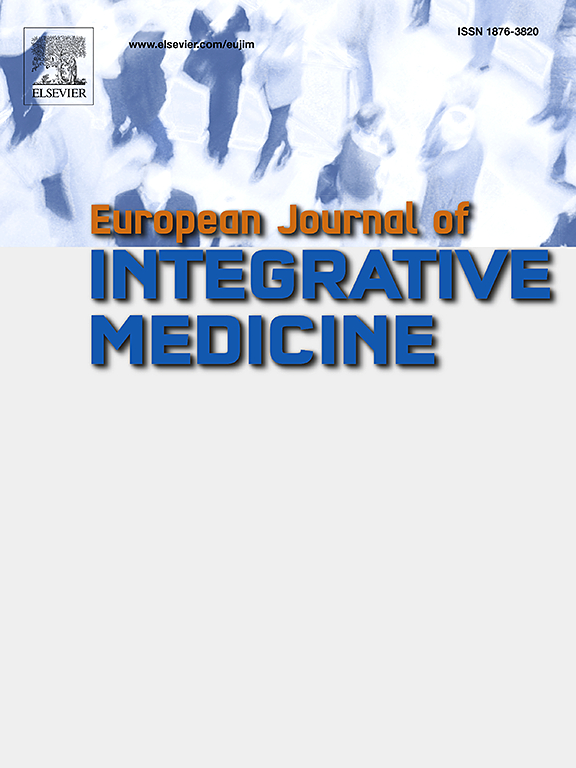使用干预描述和复制模板(TIDieR)的反射疗法具体指导:德尔菲研究
IF 1.7
4区 医学
Q3 INTEGRATIVE & COMPLEMENTARY MEDICINE
引用次数: 0
摘要
导言反射疗法是一种在脚、手、耳朵或面部进行的整体性辅助疗法。本研究旨在为研究人员和从业人员提供针对反射疗法的指导,与干预描述和复制模板(TIDieR)核对表一起使用,以提高研究文献中反射疗法干预的记录质量。方法本研究以 TIDieR 核对表为框架,开展了三轮德尔菲过程,以就作者应考虑在其研究报告中包含哪些信息以支持其干预措施的复制达成一致意见。来自欧洲、北美、亚洲和澳大拉西亚的 43 位专家(包括 40 位反射疗法专家,其中 9 位同时也是研究报告的作者)和 2 位方法论专家组成了一个多元化的小组,为指南的编写做出了贡献。43 位小组成员中有 39 到 42 人(91 % 到 98 %)完成了每轮德尔菲讨论,16 人(37 %)参加了合并会议。德尔菲小组就 46 个项目达成共识(36 个项目纳入指南,10 个项目排除在外);38 个项目未能达成共识。合并会议为指导文件的最终措辞提供了依据,该文件涵盖了 TIDieR 的所有 12 个领域。通过作为反射疗法干预研究的报告指南,该工具能够改进反射疗法干预研究的报告,从而提高反射疗法领域的可复制性和透明度。本文章由计算机程序翻译,如有差异,请以英文原文为准。
Reflexology specific guidance for using the template for the intervention description and replication (TIDieR): A delphi study
Introduction
Reflexology is a holistic, complementary therapy, carried out on the feet, hands, ears, or face. There is no single accepted definition of reflexology, as it encompasses various practices, making it important that research studies articulate exactly what the reflexology intervention entailed.
This study sought to produce reflexology-specific guidance for researchers and practitioners, for use with the Template for the Intervention Description and Replication (TIDieR) checklist, to improve the quality of the documentation of reflexology interventions within the research literature.
Method
This study used the TIDieR checklist as a framework for a three-round Delphi process to gain agreement on what information authors should consider including in their study report to support replication of their intervention. Following the Delphi process two online consolidation meetings were held to agree the wording and examples for the guidance document.
Results
Guidance based on the unique considerations of reflexology interventions was developed for use with the TIDieR checklist.
A diverse group of 43 experts from Europe, North America, Asia, and Australasia, including 40 reflexologists, 9 of whom were also study authors, and 2 methodological specialists contributed to the guidance.
Each Delphi round was completed by 39 to 42 (91 % to 98 %) of the 43 panel members, and 16 (37 %) participated in the consolidation meetings. Consensus was reached on 46 items via the Delphi rounds (36 to be included in the guidance and 10 to be excluded); 38 items failed to reach consensus. The consolidation meetings informed the final wording of the guidance document, covering all the 12 TIDieR domains.
Conclusion
The reflexology-specific guidance strongly advocates for the utilisation of the TIDieR checklist, with elaboration tailored for reflexology as used in various contexts internationally. By serving as a reporting guide for reflexology intervention studies, this tool has the capacity to improve the reporting of reflexology intervention studies, thereby facilitating replicability and promoting greater transparency within the field of reflexology.
求助全文
通过发布文献求助,成功后即可免费获取论文全文。
去求助
来源期刊

European Journal of Integrative Medicine
INTEGRATIVE & COMPLEMENTARY MEDICINE-
CiteScore
4.70
自引率
4.00%
发文量
102
审稿时长
33 days
期刊介绍:
The European Journal of Integrative Medicine (EuJIM) considers manuscripts from a wide range of complementary and integrative health care disciplines, with a particular focus on whole systems approaches, public health, self management and traditional medical systems. The journal strives to connect conventional medicine and evidence based complementary medicine. We encourage submissions reporting research with relevance for integrative clinical practice and interprofessional education.
EuJIM aims to be of interest to both conventional and integrative audiences, including healthcare practitioners, researchers, health care organisations, educationalists, and all those who seek objective and critical information on integrative medicine. To achieve this aim EuJIM provides an innovative international and interdisciplinary platform linking researchers and clinicians.
The journal focuses primarily on original research articles including systematic reviews, randomized controlled trials, other clinical studies, qualitative, observational and epidemiological studies. In addition we welcome short reviews, opinion articles and contributions relating to health services and policy, health economics and psychology.
 求助内容:
求助内容: 应助结果提醒方式:
应助结果提醒方式:


